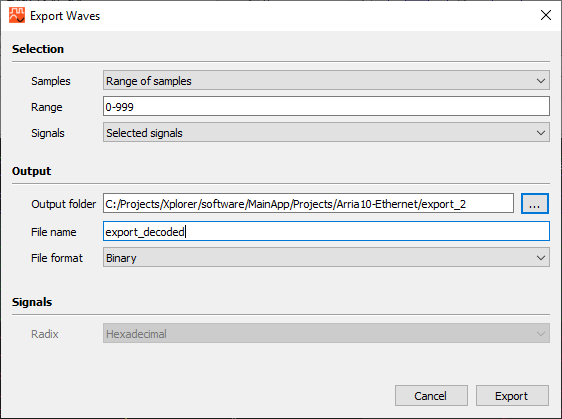EXOSTIV captures and waves can be exported to ‘binary format’ (or ‘raw format’). This article provides a description from an example.
Let’s assume that we have captured some waves into EXOSTIV’s waveform viewer, which we would like to export to raw / binary format:

When we click on the ‘Export Waves’ icon of the waveform viewer, the following window pops up, with the parameters of the export.
We select ‘Binary’ for the file format.

When we click on ‘Export’, the following files are generated:
– export_decoded.raw : the exported data in binary / raw format
– export_decoded.hdr : the ‘header’ file, a text file that provides a description the data encoded in the binary file.
The header file is a text file (csv format) that can be opened with a text editor – see the contents below

– The first row in the table contains ‘Sample Nr’ and the names of the exported signals.
– The second row provides the size in bits of the signal
– The third row provides the offset counted in byte in the binary file.
Examples:
‘exo_eth_40Gb_to_1Gb_rx.in_Valid’ is a 1-bit signal located at offset 3 in byte.
‘exo_eth_40Gb_to_1Gb_rx.in_Empty’ is a 5-bit signal located at offset 8 in byte.
In this example, each captured sample uses a space of 9 bytes.
Important: the encoding is ‘big endian’.
For instance, hereafter, for the bus ‘exo_eth_40Gb_to_1Gb_rx.in_Data(255 downto 224)’, the value ‘0xEFFFFFFA’ is written as FA FF FF EF in the output .raw file. The next byte in the file is ’02’, which is the value taken by the signal ‘exo_eth_40Gb_to_1Gb_rx.in_Empty’ in the file.
Capture:

File content:

Visibility into the FPGA.

